I’ve written about the arts — primarily dance — for many years. Please enjoy a selection of my published work:
 |
Kyle Abraham’s “The Radio Show” Los Angeles Times, 16 October 2011 “The Radio Show” mourns the loss of a central community touchstone on Pittsburgh’s airwaves. With a score by Alva Noto, mixed by Abraham with music by Ryoji Ikeda, radio chatter, hip-hop and classic soul music, the piece also evokes his father’s growing isolation as he deteriorates from Alzheimer’s. In dance terms, the choreographer interrupts flowing movement with halts. Says Abraham, “I was thinking about the synapses in the brain.” |
 |
Leaping over their Differences: Lula Washington Dance Theatre in China South China Morning Post, 12 June 2011 “The new generation is sort of bored by what is happening in China. Before they had nothing; they barely had food. Now food is abundant, but they lost something. They need excitement that there is something beyond food and spending money. I want to wake up people to show them there is more [for them] in life,” says Shawn Chen, who invited Lula Washington Dance Theatre to tour in Central China. |
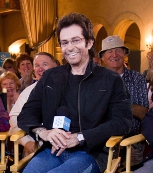 |
George Chakiris Reminisces during TCM Fest’s Dance Celebration Los Angeles Times, 2 May 2011 Chakiris danced behind Marilyn Monroe in “Diamonds Are a Girl’s Best Friend” from “Gentlemen Prefer Blondes” (1953). He said, “Jack Cole [“Gentlemen’s” choreographer] and Robert Alton were the two everyone wanted to dance for. I remember during rehearsal Cole was sitting in his chair and he got up to demonstrate. It was an explosion of dance.” “I’m so glad I got to work once for him in that incredible number. He made Jane Russell look so good too,” said Chakiris. |
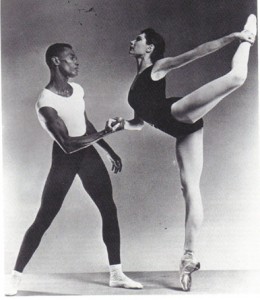 |
Talking with Dance Theatre of Harlem’s Arthur Mitchell Los Angeles Times, 7 July 2010 “Jacques d’Amboise was shooting “Seven Brides for Seven Brothers” in L.A. and I debuted in his “Western Symphony” role partnering Tanny [Balanchine’s wife, Tanaquil LeClercq]. When I stepped onto the stage, some guy, right behind the conductor, cried out, ‘Oh my god! They got a n…!’ In telling the story, Mitchell laughs while bleeping out the word. “And the place went crazy. The audience was catcalling, ‘Give him a chance!'” |
 |
An American Turn at British ‘Cinderella’ Los Angeles Times, 24 January 2010 When Frederick Ashton’s ” Cinderella” premiered at Covent Garden in December 1948, London resembled a lovely woman with ash on her face. It was a grim time. Remnants of the war lingered in the city: rubble from the blitzkrieg, treasury coffers riddled with debt, homelessness, food rationing. A splendid fairy-tale ballet — the first by a British choreographer — promised an escape. In its January 1949 review of “Cinderella,” Time magazine noted that the English audience was “eager to be enchanted.” |
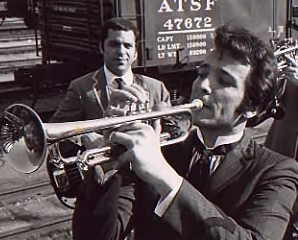 |
Alpert Award Gives Lift to Dancer Jewish Journal of Greater Los Angeles, 3 December 2009 “As multi-year gifts, they are extraordinary,” said CalArts President Steven D. Lavine, speaking about the Emerging Artist scholarships. “Herb and Lani have lived the lives of artists, and they get the struggle. They’ve been wildly successful, but they didn’t start as successful. They are full of heart, but they are also strategic about their giving. They help with practicalities, equipping artists to make a living in the real world.” |
 |
Jack Cole made Marilyn Monroe Move Los Angeles Times, 9 August 2009 The pairing could have been a hellish match. And yet these two supremely flawed people collaborated over six films. Their heady first result, the “Diamonds are a Girl’s Best Friend” sequence from “Gentlemen Prefer Blondes” is a delicious confection, a piece of Hollywood perfection. Although it is covered in Cole’s fingerprints, many are unaware that the sequence even had a choreographer. |
 |
Cutting a Fouette Figure Los Angeles Times, 5 April 2009 How did Theodore Kosloff — danseur noble, superb pantomimist, partner of Tamara Karsavina and a technical virtuoso who could toss off 18 pirouettes in succession — become L.A.’s Ballets Russes go-to guy? He reinvented himself as a dashing screen presence, a member of Cecil B. DeMille’s stock company and a cog in the Paramount Pictures publicity machine … |
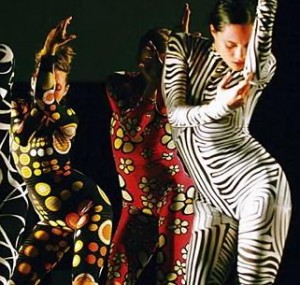 |
Batsheva Dancers Go Ga-Ga Jewish Journal of Greater Los Angeles, 27 February 2009 The company was founded in 1964 as a proper modern-dance troupe for Israeli ladies who lunch. Under Ohad Naharin’s lead since 1990, Batsheva has morphed into a movement think tank for the barefoot-and-tattoo set. No dancer in Naharin’s posse behaves remotely like a nice Jewish girl or boy; on the contrary, their willingness to dig deep for their boss seems indefatigable. |
 |
Preserving Balanchine’s Intentions Los Angeles Times, 16 October 2008 “She’s a snake,” says former ballerina Yvonne Mounsey, describing the Siren in George Balanchine’s 1929 ballet “Prodigal Son,” a role that ranks as classical ballet’s most fearsome dominatrix. In 1950, Balanchine restaged the work for New York City Ballet and cast Mounsey as the cool man-crusher in his retelling of the New Testament parable about an errant youth. The Siren was an early version of a female archetype Balanchine would return to again and again. |
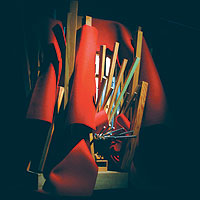 |
Frank’s Place La Opinion, 26 October 2007 While working on a project in Lisbon architect Frank Gehry first heard Mariza sing. He was enchanted by the city and its fado music. A friendship grew, and Gehry, who had never collaborated with a performer, offered to design Mariza a temporary stage-set of a Lisbon taverna inside his own architectural gem, Walt Disney Concert Hall. |
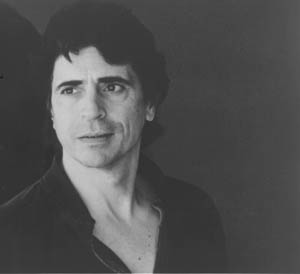 |
Guardian of Balanchine La Opinion, 28 June 2006 Edward Villella’s passion for dance and for the neo-classical works of his mentor George Balanchine, for whom he danced for two decades, are gloriously evident in the rambunctious troupe Villella has built in Miami from the ground up. The consensus in the ballet world is that the 70-year-old Villella has proven a fine caretaker of Balanchine’s brilliant legacy of twentieth-century choreography. |
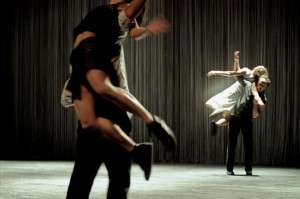 |
Spiegel’s Mirror La Opinion, 30 April 2008 Brussels-based experimental dance-theater Ultima Vez burns a heady fuel of furious physicality and raw emotion. With this weekend’s Los Angeles performances of Spiegel (German for “mirror”), the troupe’s 45-year-old founder/choreographer, Wim Vandekeybus, marks twenty years of vivid and powerful multimedia dance making. |
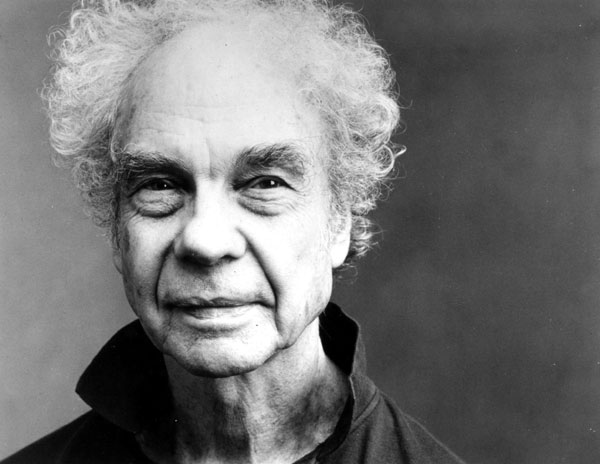 |
Rock On, Merce Cunningham La Opinion, 31 May 2005 How does choreographic decision-making by rolling dice affect a dance performance? It gives it the vitality and unpredictability of real life. It adds a dollop of irony, because the Great Artist is slyly admitting that his own choices and preferences are equal to, or even less compelling than, the toss of dice. The entire audio/visual experience is so stimulating your brain may tingle for days. You may join the many well wishers who urge the great master to “Rock on!” |
 |
Sax Redux Scene, 28 May 2008 “Who wants to solo? Come on, go for it!” urges saxophone coach Matt Otto, his words rising above the din of forty sax players as they chug through Tito Puente’s Oye Como Va. One brave soul, his tenor sax at the ready, rises from his chair and warbles a solo above the churning rumba beat. “Loosen your lip. No tugging,” says team-teacher Michael Turre, speaking a secret code that only sax players can understand. “Don’t bite so hard,” he adds. The students all pitch forward in their chairs and emit an earthy vibrato that nearly rattles the Dorothy Chandler Pavilion’s glass chandeliers. |
 |
Return of the Prodigal Son La Opinion, 22 March 2006 Jose Limón’s career took place in New York City, and because he was extremely reticent, if not purposefully vague, about his youth in Los Angeles, it is not widely known that this great artist grew up here, graduating with honors from Abraham Lincoln High School in 1926, and majoring in art at UCLA for one year. In upcoming performances of the Limón Dance Company at the Music Center, Los Angeles hopes to reclaim its native son. |
